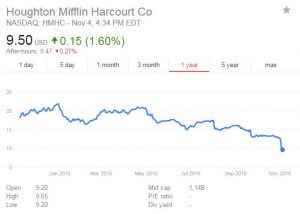Houghton Mifflin Harcourt Blames Miscues in Calif. ELA Adoption for Lower Market Share
Officials at Houghton Mifflin Harcourt, one of the largest K-12 content providers, admitted on Nov. 3 that the company had lost 3 to 4 percent market share in the domestic education market, largely because of a failure to create new reading programs for California’s latest English/language arts adoption.
“Instead, we offered a California standards-based reading program that used as a foundation our existing industry-leading reading program, coupled with new technology and enhancements,” the company’s interim CEO L. Gordon Crovitz told analysts and investors on the third-quarter earnings call.
The company did not do an effective job of marketing the program’s enhancements, Crovitz said, and the perception in the marketplace was that the California reading program wasn’t new. That had a “cascading” impact on market share in other reading and English/language arts adoptions in 2016, he said.
Increased competition also played a role in the loss of anticipated annual market share, from 42 percent in 2015 to an anticipated 38 or 39 percent this year, Crovitz said.

Houghton Mifflin Harcourt missed its target earnings per share of 73 cents by 15 cents, or $49.6 million, the company reported. Net income for the third quarter was $90 million, a 31 percent decrease compared with $131 million for the same period in 2015.
Another factor in the reduced earnings was fact that the company planned for greater sales from its acquisition of what it calls “the ed-tech business” from Scholastic last year, according to Joseph Abbott, the company’s CFO. Scholastic divested itself of its digital intervention services for struggling learners.
“While we anticipate increased growth from this acquisition, we now anticipate that we will deliver single-digit growth” this year from acquiring that portion of Scholastic’s business in 2015, he said in the earnings call.
Addressing the Problems
The company, in its release, said it has made a “solid performance in other adoption opportunities, including California math and Florida literature,” and that it plans to invest in its core curriculum programs to improve its competitive position in the future.
This year, Houghton Mifflin Harcourt said it will invest $120 million to $140 million in content development. Still, the company invested 12 percent less in the third quarter of 2016—$29 million—than it did during the same period in 2015, when it spent $33 million to underwrite content development.
It recently launched a new science program called HMH Science Dimensions, which it said is “built from the ground up” to meet the Next Generation Science Standards adopted by many states, and it plans to offer new instructional programs in social studies, reading, and math for applicable states in 2017, 2018 and 2019.
Crovitz said the company plans to continue investing in intervention, assessment, professional services, international, and the consumer markets.
As it became clear that Houghton Mifflin Harcourt’s financial performance would not hit projections, the company’s board decided in late September to make a leadership change, announcing the resignation of five-year CEO Linda Zecher, and appointing Crovitz as interim CEO. Crovitz credited Zecher with leading the company’s initial public offering, and migrating much of its business to digital, he said on the call. Now, in its core programs, the company said its digital sales are in “the upper 40s percent,” said Abbott.
Houghton Mifflin Harcourt, which is a global learning company that says it serves more than 50 million students in over 150 countries worldwide, is now “squarely focused on restoring growth to the business,” Crovitz said in the company’s release.
The Seeking Alpha website offers a full transcript of the Houghton Mifflin Harcourt’s third-quarter earnings call. The company’s press release about its results are available here.
See also:
- California Set to Adopt Literacy Materials Tied to Common Core
- Houghton Mifflin Harcourt to Acquire Scholastic Ed-Tech Businesses for $575M
- Houghton Mifflin Harcourt Launches ‘Marketplace’ for Developers, Educators
- Houghton Mifflin Harcourt Goes Public

Impressive article well explained. Amazing And I Think Your Content Is Higher Level. Nice, Post Sir Thanks a lot for such great information.